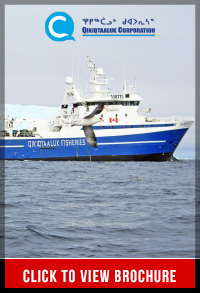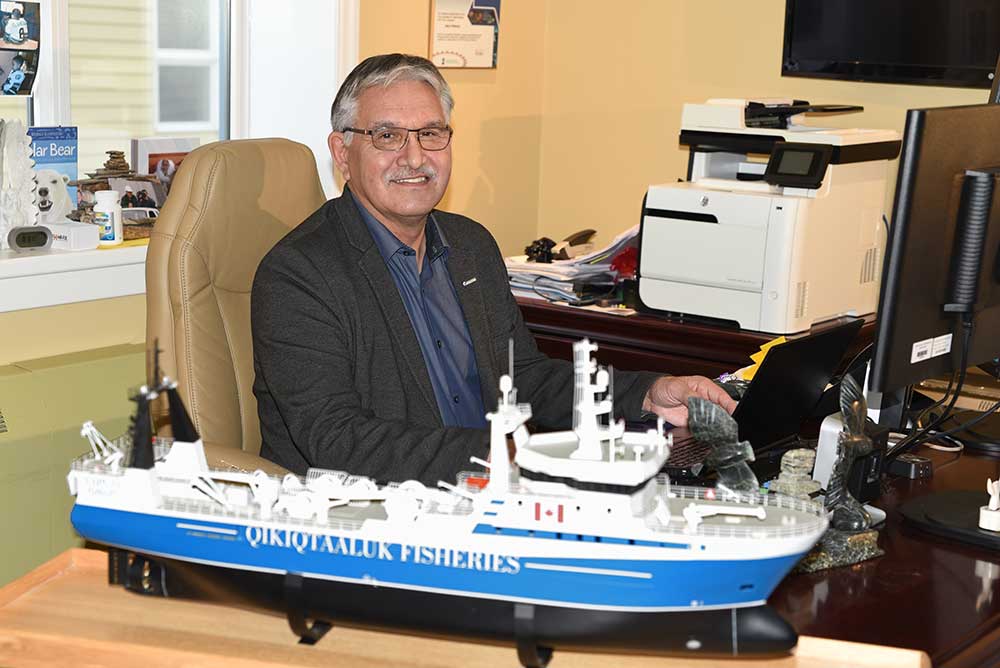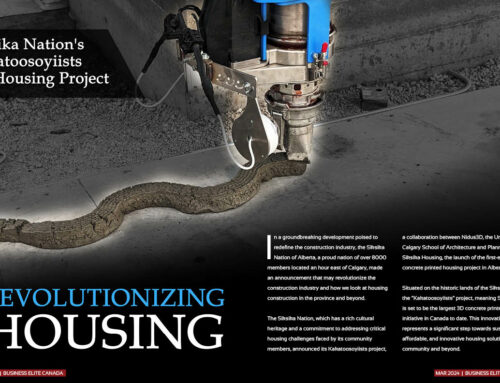Partnership, Innovation, and Investment in Canada’s North
By Anna Guy
 As President and CEO of Qikiqtaaluk Corporation and Group of Companies (QC), Harry Flaherty estimates he spends 50 per cent of his year travelling across Canada. Flaherty’s mission is to generate economic development and employment opportunities for Inuit in the Qikiqtani region, which includes 13 communities from Grise Fiord in the High Arctic down to Sanikiluaq.
As President and CEO of Qikiqtaaluk Corporation and Group of Companies (QC), Harry Flaherty estimates he spends 50 per cent of his year travelling across Canada. Flaherty’s mission is to generate economic development and employment opportunities for Inuit in the Qikiqtani region, which includes 13 communities from Grise Fiord in the High Arctic down to Sanikiluaq.
QC is the Regional Inuit Birthright Development Corporation owned by the Qikiqtani Inuit Association (QIA)—the Regional Inuit Organization as defined by the Nunavut Land Claims Agreement, representing the 14,000 Inuit in the Qikiqtani (Baffin) Region of Nunavut.
QC was incorporated in 1983, and in 34 short years, has grown into an economic driver in the region, known as an experienced and reliable partner in industrial, institutional, and infrastructure development. QC is highly active in fisheries, real estate and industrial development, retail services, environmental services, in the mining sector, and the human resources development sector in general.
QBDC
“With the capacity QC has developed over the years, we are now well positioned to support the Qikiqtani communities, in the delivery of essential social and economic infrastructure,” Flaherty says. “We envision that a partnership approach will establish a viable alternative for the delivery of essential infrastructure, in a manner that builds community capacity, advances social and economic opportunities and compliments the traditional delivery methods for essential community infrastructure.”
In order to work toward creating opportunities within the Qikiqtani communities, on April 1, 2016, the QC Board of Directors approved the creation of the Qikiqtaaluk Business Development Corporation (QBDC) with a mandate to create partnerships, align Investments and utilize emerging technologies that will improve community self-reliance.
Fisheries
“The QIA realised they needed a development company in order to oversee some potential business opportunities within the region,” Flaherty says. “In 1983, the QC was created as the for-profit arm of the QIA. At the time, the QC was given the first offshore fishing licence to harvest the shrimp and turbot in adjacent waters.”
Today there are 17 northern shrimp licenses in the Canadian Northern Shrimp Fishery, and QC holds 9 per cent of all the offshore shrimp in Canada (1.5 of these licenses). In 2004, QC purchased a 64-metre factory vessel and created Qikiqtaaluk Fisheries Corporation (QFC). In 2012, the vessel underwent a major retrofit and was extended to 76 metres.
Royalties from offshore licences were also invested in building QC’s other lines of business and increase Inuit employment.
Real Estate
Once established in the fishing industry, QC widened its horizons to the real estate industry—establishing itself as the second-largest real estate holder in Nunavut, with holdings of over $100 million.
Flaherty gave this interview from QC’s Igluvut Building (the anchor of downtown Iqaluit), which serves as the Iqaluit office for Nunavut Tunngavik Inc. and the Qikiqtani Inuit Association, Member of Parliament Hunter Tootoo, as well as the home of the RBC Bank.
“We built a 5,000-square-foot office facility, which was the first of its kind in Iqaluit,” Flaherty says. “From there we have been growing gradually in the market where we have a number of large office buildings and warehouses that we lease to the federal government and other business within Iqaluit.”
Because of the very limited available property in downtown core of Iqaluit, QC is in a very advantageous position as one of the only companies with undeveloped land in the area, ripe for further development. QBDC is working to advance the first private municipal land development initiative in Nunavut, on behalf of the Qikiqtani Inuit Association, which consist of a parcel of Inuit Owned Land (IOL) located in the future core area of Iqaluit.
While the IOL development is in itself a unique initiative within Nunavut, has been collaborating with the City of Iqaluit to create a complimentary municipal subdivision adjacent to the IOL parcel. Commonly known as the Federal Road development area, once completed the IOL will host a combination of facilities that will provide Inuit with enhanced economic opportunities and [promote essential program delivery for both Inuit and the broader community. The municipal subdivision being considered would support the critical need for housing lots as well as providing a portion of this land to accommodate the long-awaited Nunavut Heritage Center.
The first facility scheduled for construction within the IOL development is a new Hotel and Conference Center scheduled for occupancy in the fall of 2019. The Hotel will consist of 92 rooms including 12 suites dedicated to the 12 Qikiqtani communities outside of Iqaluit. A conference facility with a restaurant, lounge and spa will provide future patrons with a truly unique Arctic experience.
Under Flaherty’s leadership (first as Director and since 2009 as President & CEO), QC has continued to grow and own 10 wholly-owned companies and 16 joint venture companies. Though “fishing licences and real estate are our number one and two corporations that provide stability and revenue for QC and group of companies,” according to Flaherty, its subsidiaries have notable successes as well. For one, it is the first Inuit-owned company to participate in a Public-Private Partnership with the Government of Nunavut for the construction of the first hospital in Nunavut, as well as the first Inuit-owned company to secure bonding as “prime contractor” for a multi-million environmental project. Next on the docket, the QC will play a vital role in the region’s push toward clean energy.
Maximizing Inuit Employment and Community Initiatives
“Part of our mandate is to provide employment opportunities, including training, for Inuit” Flaherty says. The numbers show its success in this area. QC boosts the highest share of Inuit employees of any NU private employer. 81 per cent, or 360 out of 443 employees are Inuit, earning $7.5 million in salaries. Compare this to 50 per cent Inuit employment rate in the Government of Nunavut (March 2017) and closer to 20 per cent in the mining industry.
QC is now working to strengthen the relation with the communities in the Qikiqtani Region to assist with future infrastructure projects and provide support to the communities to achieve their economic objectives. QC is a “one-stop business partner” in development, servicing and management in the communities and on remote sites throughout Nunavut. Recently, QC has been working with the community of Grise Fiord on the design and funding of a potential new lodge and cultural centre in the community. QC has also been supporting the community of Qikiqtarjuaq on a potential deep-water port for the community. In 2017, QC has worked with the community of Cape Dorset on a metal clean-up project, and with the community of Sanikiluaq to conduct a wind study and install a met tower.
“We also work diligently to ensure our people feel ownership in the QC,” Flaherty says. “We are owned by the Inuit in the 13 surrounding communities, and giving back is very important.”
The QC creates sponsorships and charitable contributions for cultural, community, and youth development initiatives, along with yearly dividend payments to the QIA, which in the 2016-2017 fiscal year alone amounted to $1,063,157. As recently as November, QIA pledged $5 million towards the creation of the Nunavut Heritage Center, along with a new program aimed at delivering capacity building and increased culturally and linguistically relevant early childcare resources.
Clean Energy: The Next Step
One of the more interesting opportunities that QBDC has been working on is the development of a Regional and Community Clean Energy ownership model. Flaherty has long advocated that QC, and indeed all Nunavut Agreement development corporations, can be an effective partner with Federal, Territorial and Municipal Governments in collaboration with the Quiliq Energy Corporation.
Flaherty suggest that such a partnership approach would focus the transition from our reliance on imported diesel for the generation of electricity and to heat our buildings, to that of a next generation regional community clean energy system. With the annual reoccurring expenditures necessary to purchase, transport, store, and burn imported fossil fuels, coupled with advancements in energy efficiency, generation technologies, and battery storage (along with significant Government of Canada Clean Energy investments being promoted), “it seems natural that the time is right for Inuit to harness and directly benefit from the natural energy resources available within each of our communities, our regions and our Territory,” says Flaherty.
Flaherty says the QC wants to be a leader in Northern clean energy, and is taking steps to lessen the dependence on generators and diesel within the next five years. “For economic and environmental reasons, clean energy will help improve our communities,” Flaherty says. “All of Nunavut’s 25 communities and five out of six communities in the Inuvialuit Settlement Region in the Northwest Territories are dependent on diesel-generated electricity, and the next five years we will be focusing on what we can do regarding clean energy, specifically wind energy and hydroelectricity. The high cost of electricity and fuel in Nunavut is no longer acceptable with the new technology that is available now.”
The QC, through the QIA, is a member of the Arctic Renewable Energy Expert Committee, an alliance of six organizations spanning from Alaska to Iqaluit to Waterloo, ON, whose mandate is to help bring scalable renewable-energy pilot projects to at least three northern communities by 2020.
“Diesel use in Arctic communities hurts the environment and costs a lot of money,” said Paul Crowley, the WWF’s vice president of Arctic conservation, in a March 31 release. “It’s not just the climate and air quality threats that we’re concerned about, but the potential for diesel spills when shipping the fuel north. “By switching to habitat-friendly renewable energy, communities can become more self-reliant and will be protecting marine environments and the species that depend on them,” Crowley concludes.
Other activities such as promoting a regional and community waste management approach, researching an affordable home ownership model through community micro-manufacturing, supporting the community of Qikiqtarjuaq in its efforts to develop a deep sea port, undertaking site specific studies for hydro potential in Pangnirtung, validation of wind resources in Sanikiluaq and Iqaluit along with solar and 21st Century micro-grid studies is building our internal capacity so we can collaborate with all Qikiqtani communities as they contemplate their future clean energy objectives.
“We ourselves have been lobbying with the Nunavut and Federal government and work closely with Native groups like ourselves,” Flaherty says. “We want to see the gap between both groups closed, and have Native groups be involved strategically from the very beginning of any discussion on infrastructure and opportunities on this or other initiatives. We will work to see that happen.”
Flaherty says he will be back on a plane tomorrow, to do just that.






